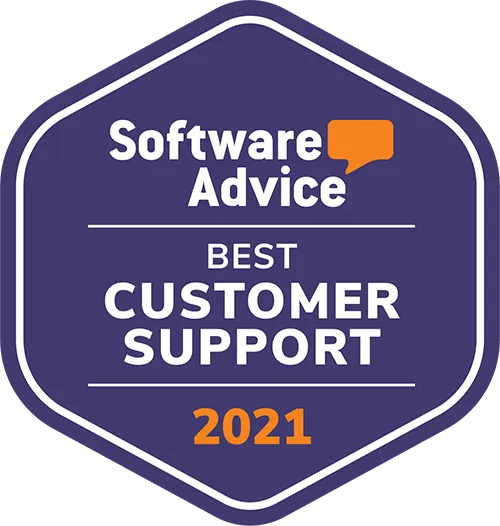It wasn’t a hard choice to select SmartSurvey. Not only did they understand what we were looking to achieve right from the start, they presented a solution that represented everything we needed.
Survey Format
Survey Format

Working to maximise the appeal and performance of your survey…
When it comes to your survey, you only get one chance to grab your respondent’s attention, engage and convince them to complete your survey, so you’ve really got to make it count. This is where the format for a survey and its design is so important, as not only does it help you to maximise engagement, but ensure your survey is easy to read, comprehend and answer once a respondent has committed to completing it.
There are a number of key areas you need to look at with regards to the format of your survey and your survey layout, if you’re to achieve this and maximise your response.
The survey title
Your survey title is the first thing potential respondents see, so it’s crucial to ensure it’s as compelling as you can make it.
While a short and concise title is easier to understand, it’s also more likely to grab attention. However, it’s also important to ensure that your title can provide an insight into the purpose and content of your research.
The survey introduction
Your survey introduction is essential too, because as well as providing an effective overview of your survey’s purpose, it should also help to set the expectations of those looking to participate.
Here are some key elements to consider including if you’re to make it as strong as you can.
- State who you are and your survey’s purpose: it may sound obvious, but it’s important to provide your company name and maybe some very basic information about yourself, as people will be reluctant to share data if your company’s status is not clear. Clarity over the aim of your survey also helps and increases the perception that you’re trustworthy and your cause is worth supporting.
- Explain why a respondent has been chosen: every survey has a target audience, so if you can explain to a recipient why you are targeting them, which could be because they fit into a particular age group, then it’s far more likely to increase their recognition and interest in helping you.
- The privacy issue: as well as revealing whether your survey is anonymous, confidential or neither of these, it’s also important to be clear and upfront about exactly how you intend to use respondents’ data, if you’re to encourage them answer your questions truthfully.
- State how long it will take to complete: this is a key part of setting respondent expectations. If you’re honest and upfront about the length of your survey, you’re less likely to risk people abandoning it once they start working their way through it.
The survey questions
Having enticed respondents with a compelling survey title and introduction, you’ll want to ensure they get to the end of your survey. So, you need to ensure have a structured questionnaire with the right questions for the purpose of your survey and the audience that will be answering them.
Here’s a handy checklist of essentials to think about before you start writing your survey questions:
How many questions?
While there is considerable debate about how many questions to include in a survey, generally you can get a better feel for this by thinking about how long it will take to complete, as this can be affected by your choice of question type with open-ended or free text questions typically taking longer to answer.
Ideally you don’t want your survey completion time to run beyond 10 minutes. However, this can still vary depending on your survey type and the audience you’re trying to reach. For example, if you were looking to survey your customers you would have less control over them completing your survey than if you were running an employee survey making it more crucial to keep your customer survey short and concise than when working with an employee target audience.
It’s also worth bearing in mind that during longer surveys participants tend to answer each question much quicker than they would for a shorter survey, which can negatively affect the accuracy of your findings – making the case keeping your survey shorter even stronger.
Common question types
At the most basic level, when it comes to questions there are two main types you can choose from open or closed questions, with the former offering the best approach for collecting qualitative data and the latter quantitative data. While open questions are unstructured in order to give respondents the space, they need to fully express themselves when they’re answering a question, closed questions are designed to gather data more easily and quickly, with respondents typically asked to provide either Yes or No answers or select their answers from a pre-set list of options.
Depending on your research, whether it’s qualitative, quantitative, or a bit of both you may choose to go with just open-ended or closed questions or a mix of both. However, if you do select open-ended questions, it’s best to limit the volume of questions you use, to prevent it being detrimental to your survey’s completion time.
If you choose to use closed questions, there’s a wide range of options available. From multiple choice questions presented to respondents with single select or multi-select options in a range of formats such as Likert scale, rating and ranking questions, to matrix grid questions or dichotomous questions, where participants are offered just two option to choose from ‘Yes or No’ or ‘True of False’.
For multiple choice questions where the answer choices provided are not exhaustive, you could think about including an ‘other textbox’ or ‘comment field’ to ensure you don’t miss out on a respondent’s feedback, if they feel the other choices provided don’t best reflect how they feel.
With such a wide range of question types you have the option to mix up the format of your questions, and this can help you to keep respondents engaged and ensure they make it to the end of your survey.
Question order and flow
To get your survey off to the best possible start and really grab your respondents’ attention, it’s best to begin it with your simplest and most interesting questions, while placing more difficult questions towards the end.
Quality survey questions should always strive to elicit the information you need. So, you should look to ensure your questions follow in a logical order, while grouping together those that relate to one another.
Advanced features
When it comes to your online survey format, you should also think about incorporating any smart logic and actions that you’re able to access into your questionnaire, as these also help to ensure the right question flow and relevance for the respondent.
Good examples of smart features include skip logic, which enable you to hide irrelevant pages from a respondent based on the answers they have provided on previous pages and even skip them past entire sections. With the addition of piping, answers from previous questions can also be inserted into upcoming questions automatically and where relevant to save respondents time.
Language
Whatever audience you’re targeting, it’s important to use simple language that you know will be universally understood by your respondents.
Try to use common, simple words, where there is little room for alternative interpretation. You also want to try to avoid double negatives and any acronyms, jargon, or slang that respondents may be unfamiliar with, which could leave people confused on stuck on a question.
To reduce the risk of bias creeping into your survey, you also want to avoid subjective language, whether direct or more subtle, such as with the questions from, “Isn’t our service great?” to “Do you frequently buy spinach?”
The visual design
While it’s essential to get your questionnaire layout and your questionnaire format right, it’s also important to know how much your survey design complements this and needs to be as good as you can make it, if you’re going to maximise your survey’s engagement and response rates.
Once again, there is plenty to consider when you’re thinking about your survey’s design structure.
Branded or unbranded survey?
This really depends on the audience you’re surveying or what you’re looking to find out.
If you were looking to survey your customers, whether through a customer satisfaction or a customer experience survey, a branded survey would be the best way to go, as it clarifies exactly who the survey is sent from, increasing trust among recipients, and making them more likely to take your survey.
This contrasts to sending a survey internally to your employees, or maybe in a situation where you were conducting covert research, such as in a survey of your customers to see how they rate you and your competitors in terms of your product features, experiences, and the support you provide. In both instances, a more basic survey format, without branding would be sufficient and actually more helpful in the covert research example, because if it was obvious that the survey was coming from your company this could bias some of your participants’ responses.
When it comes to getting your brand’s look and feel into your survey, you need to consider customising everything from your logo and background image to your fonts and colours, so they reflect the look of other branded collateral that you produce. You can achieve an even more professional look by customising your survey’s web address or through using your own sub domain.
Font size and colour
Although we’ve already touched on fonts and colours, it’s worth emphasising just how important they are to the readability of your survey.
It’s essential that the text to your survey is easy to read, as it can mean the difference between people continuing to complete or choosing to abandon your survey. While some font styles and sizes can look better on a page than others, the same can be said with colours, with lighter colours generally deemed harder to read than darker coloured fonts, which better facilitate readability.
It’s why we have a huge library of themes for you to choose from, to help you to get the right look and feel for your survey. And if this still isn’t enough, we provide an editing tool, so you can customise a theme with colours and font selections that you believe will best work for you.
Making sure your survey is readable by everyone is also crucial for accessibility, as many respondents may have a disability such as a visual impairment, which could be preventing them from participating. In fact, accessibility compliance is mandatory for UK government and public sector clients.
Number of questions on the page
The way in which questions are displayed on your survey can also have an impact on your engagement and overall completion rate, depending on your audience and the devices they’re most likely to be taking your survey on. So, you need to give this some consideration to this when you’re thinking about your questionnaire’s structure and design.
For example, if you’re creating a customer satisfaction survey and your products or services are aimed at a mainly younger audience, it’s likely they could take you survey on a range of devices and screen sizes. In this scenario, you may better off formatting your survey, so that its questions are presented to the user’s device screen one at a time and they have to press the Next button to progress to the next one, or as a single screen survey, where the questions are displayed without page breaks and the user scrolls downwards to get to the next question. Question formatting such as this is likely to work best for smartphone users.
Alternatively, if you were running a survey for an internal audience, such as an employee engagement survey, where respondents were more likely to access the survey on a desktop machine, having grouped questions on each page may be more effective.
Use of subheadings
Similarly, as well as the number of questions on the survey page, the use subheadings within your survey can help with visibility and clarity and ultimately moving respondents smoothly through your survey.
While the use of subheadings can help you to categorise various sections within your survey, they can also be useful in sub dividing and clarifying longer multiple-choice pick list style questions.
For example, if you were asking respondents a question about which computing devices they own, you might want to sub divide your question with the following subheadings and options such as:
Desktop computer (Windows, Apple Mac)
Laptop computers (Windows, Apple Mac)
Tablet computers (Apple iPad, Android tablet, Windows Surface)
Smartphone (Apple iphone, Android, Windows)
The survey conclusion
Although it comes at the end, the conclusion is as important to your survey structure as the other sections contained within it and is essential to ensuring your respondents leave your survey on a positive note.
Thank you message
The main thrust of your conclusion needs to include a thank you message, which is only polite when participants have given up their time and insights to help you.
Besides acknowledging an appreciation for their support, it also needs to offer something positive for them to take away, as you may need their help again in the future. This may include a commitment to communicate with them again with a link to your survey report findings and action plan of how you will use their feedback, as soon as you have gathered and analysed all your survey results.
Exit URL
While you will want to track respondents, who leave your survey early, so it’s easier to measure the number of people who’ve not completed your survey, it can also be valuable to redirect those that complete your survey to another page.
Typically, this can be the home page of our website, or some other pages on your website related to what they’ve just been answering, as this can provide further opportunities to engage, communicate and sell to them.
A survey completion redirect, is fairly simple to do with survey software such as our own, by ticking a checkbox to activate the automatic redirect function and adding the address in the URL box you want it to redirect to.
Don’t forget to test your survey
From the clarity of your questions, fonts and colours, to the length of time and ease with which respondents were able to complete your survey, testing your questionnaire with a sample of your audience is a great way to fix any issues and maximise your survey’s success. Do this before you launch your survey for real.
How are we different?
UK based
Your data will be stored and processed here in the UK for your peace of mind.
Fanatical support
We pride ourselves on going above and beyond for our customers, providing expert advice and support whenever you need it.
You're in safe hands
Our secure platform and robust data protection measures ensure your data is safe and secure with us. We are ISO27001 and Cyber Essentials Plus certified.
We're human
We understand the importance of personal interaction, which is why we offer a human touch alongside our cutting-edge technology.
Accessibility matters
We're committed to making our surveys accessible to everyone, with a range of features to support those with disabilities.
Unlimited responses
With no limits on the number of responses you can collect, you can be sure your survey will reach as many people as possible without it being cost prohibitive.

Don’t just take our word for it
Over 500,000 users have registered to use SmartSurvey.


We couldn't be happier with SmartSurvey, we love its functionality and flexibility. This means we have been able to use one survey tool across many parts of the business.








Get in touch
We are ISO27001 certified, registered under the Data Protection Act and fully compliant with EU Privacy Laws.
Access to a knowledgeable account manager for personal assistance for when you most need it.
Our friendly design team is on hand to assist with any bespoke design and custom development requests.
We succeed if you succeed. Our goal is to help you carry out effective research and we’re here to help you achieve that.
